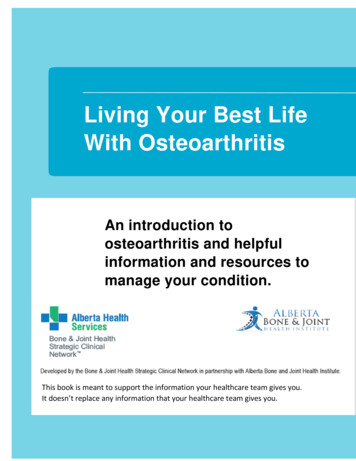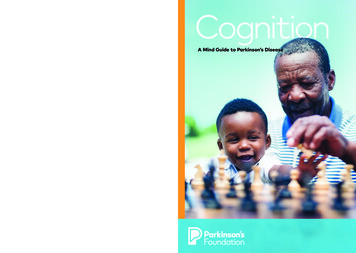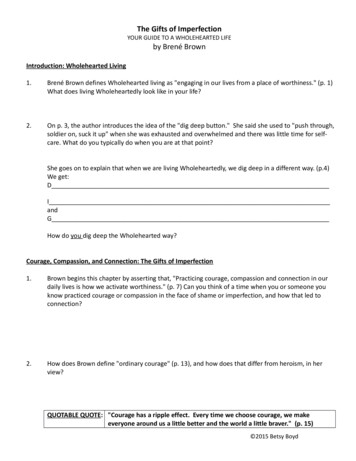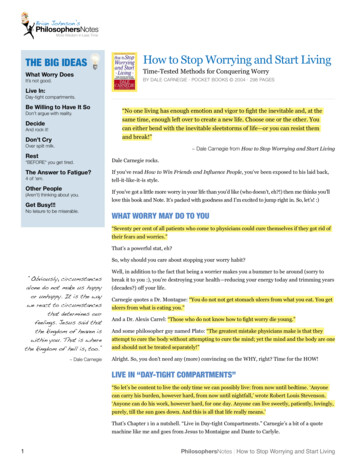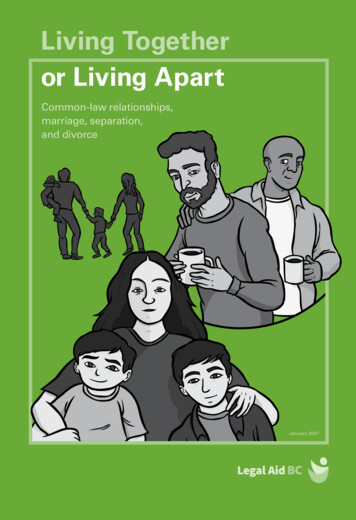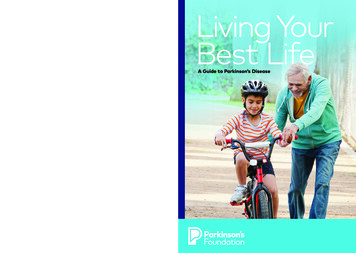
Transcription
Living YourBest LifeA Guide to Parkinson’s Disease200 SE 1st Street, Suite 800Miami, Florida 331311359 Broadway, Suite 1509New York, New York 10018helpline:800. 4PD.INFO (473.4636)helpline@parkinson.orgparkinson. org
About the Parkinson’s FoundationThe Parkinson’s Foundation makes life better for people with Parkinson’sdisease by improving care and advancing research toward a cure.In everything we do, we build on the energy, experience and passionof our global Parkinson’s community. A wealth of information aboutParkinson’s and about our activities and resources is available on ourwebsite, Parkinson.org.Your feedback matters!We’d like to know what you think of our publications and programs.Please take a few moments to fill out our online feedback form.Your answers will be used to improve our resources and will benefitpeople with Parkinson’s, caregivers, families and others in theParkinson’s community. Thank you for your help.Online form:Parkinson.org/FeedbackYour generosity makes this publication possible.The Parkinson’s Foundation is proud to provide this booklet and othereducational materials at no cost to people around the globe. If you foundthis book helpful, please consider a gift so that we may continue to fightParkinson’s on all fronts: funding innovative research, providing supportservices and offering educational materials such as this publication.Thank you for your support.Donate online:Parkinson.org/DonateDonate by mail: Parkinson’s Foundation200 SE 1st St, Suite 800Miami, FL 33131parkinson’s foundation resourcesYou can find more helpful tips for managing Parkinson’sin the books, fact sheets, videos, webinars andpodcasts in our PD library at Parkinson.org/Library.Donate by phone:1-800-4PD-INFO (473-4636)Tax ID:13-1866796The information contained in this publication is provided for informational and educationalpurposes only and should not be construed to be a diagnosis, treatment, regimen or anyother healthcare advice or instruction. The reader should seek his or her own medical orother professional advice, which this publication is not intended to replace or supplement.The Parkinson’s Foundation disclaims any responsibility and liability of any kind inconnection with the reader,s use of the information contained herein. 2019
1You may be reading this book because you or someonein your life recently received a diagnosis of Parkinson’sdisease (PD). Perhaps it was not so recently, but you arenow reflecting more on what the diagnosis means foryou. Everyone’s PD story is different. Many people withPD vividly remember the moment they were diagnosedand view it as the beginning of a journey; a new life path.Often, they think back a few years and recognize subtlesymptoms they missed at the time.It is our hope that this book will provide you with tools toprocess and effectively cope with the disease, whetheryou were diagnosed with PD or a loved one recentlyshared their diagnosis with you. This book is meant to be astepping-stone for working this diagnosis into your life andto offer an opportunity to learn how you or your loved onecan live well with PD.
sDiagnosis9PhysicalWellness29Summary41
3Coping withParkinson’s16Appendix A 43Appendix B 45Appendix C 46Appendix D 47
AcknowledgementsThis book was written and reviewed by:Nina M. Browner, MDJessica Shurer, MSW, LCSWUniversity of North Carolina, Chapel HillAnnie Wallis, MSW, of the Parkinson’sFoundation also contributed to the writingand review of this guide.Design: Ultravirgo
5chapter oneAbout Parkinson’sDiseaseYou may already be somewhat familiar with Parkinson’sdisease. This book will focus more on the aspectsof living and coping with PD and less on symptomsand medications.Briefly, PD is a complex disorder of the brain that involves themalfunction and death of brain nerve cells, called neurons, that producea neurotransmitter, or chemical in the brain, called dopamine. Dopaminehelps people control, coordinate and smooth movements, so with lessdopamine in the brain people with PD experience motor symptoms, orsymptoms that relate to movement, such as tremor, slowness, stiffness,difficulty controlling smaller movements, posture changes and imbalance.Since dopamine is also important for other functions of the body, speechand voice, sleep, bowel motility, cognitive function and mood may beaffected. These types of symptoms are called “non-motor symptoms” andcan be present along with motor symptoms. Having PD does not mean youcan expect to have all of these symptoms. Each person experiences PD alittle differently.
6living your best life with parkinson’sIt is estimated that about one million Americans and more than 10 millionpeople worldwide are living with PD. It is thought to impact men slightlymore than women, but since it is often experienced differently by women,many suspect it may be underdiagnosed among them, as well as non-whitepopulations. The exact cause of PD is still not known but is thought to be acombination of genetics and environmental causes in most cases.Parkinson’s is often diagnosed by a neurologist who performs anexamination and reviews symptoms, medical history, medications andfamily history. Additional tests, such as a brain scan, may also be done.Currently there is no cure, but there are many treatments and lifestylemodifications available to effectively manage PD. These include acombination of medications, exercise, rehabilitation therapies, interventionsto address safety and mental health and sometimes surgeries.People with PD benefit from regular visits with a general neurologistor a movement disorders specialist – a neurologist who went throughadditional training in PD and movement disorders. During appointmentswith your physician, you should discuss both your motor and non-motorsymptoms, especially those that are new, bothersome or concerning for you.Treatment options for these symptoms can be offered to improve your dailyfunctioning and quality of life.Parkinson’s is considered progressive, meaning that many of the symptomscan worsen over time. The rate of progression is often hard to predict andvaries from person to person. That being said, people with PD can live full,meaningful lives, especially if they manage their symptoms and safetyappropriately and tap into the right care and resources.To learn more about PD symptoms and treatment and order relatedresources, such as Frequently Asked Questions or Medications, visitParkinson.org/Books or call the Parkinson’s Foundation Helpline at1-800-4PD-INFO (473-4636).“ The worst day of this disease was the day I was diagnosed. I was stunned.But the best day was when I understood that there were changes I couldmake in my life to help manage it and still live well. It gave me back asense of control in my life, and some power.”Phyllis, 63, five years after diagnosis
About Parkinson’s Disease7Living your best life with Parkinson’s DiseaseFollow Jeff’s Parkinson’s journey throughout this bookAfter 40 years as an engineer, Jeff started noticing that he was a bitslower with his work performance and since he “was the right ageand was offered a good retirement package” he decided to retire.Shortly after retirement, Jeff and Betty, his wife of 39 years, movedfrom New York to North Carolina to live closer to their daughter andgrandchildren. About eight months ago, Betty started urging Jeff totalk with his family doctor. He was still experiencing stiffness in hisright arm, despite having undergone surgery for a “frozen shoulder”last year and was having intermittent shaking in his right hand. Jeff’sfamily doctor recommended that he be evaluated for Parkinson’sdisease by a neurologist who specializes in movement disorders.During the three months leading up to the neurologyappointment, Jeff felt uneasy and anxious. “There is noone in my family diagnosed with Parkinson’s. I’ve alwaysbeen an active, healthy person. I couldn’t haveParkinson’s, right?” He and Betty looked up Parkinson’son the internet and became overwhelmed by theinformation they read, including all the possiblesymptoms and medications.Jeff’s story may or may not sound familiar. Everyone’s PD story is different.Like Jeff, you might be thinking about what the diagnosis means for youand your family’s future. You may have questions about why this happenedto you. Wrapping your head around a medical diagnosis, understandingwhat comes with it and making related decisions – such as where to seekcare and when to start medications – can leave you feeling confused andanxious. This is especially the case if you do not feel that you understandwhat to expect from your life with PD.
8living your best life with parkinson’sMost likely, your doctor offered some explanation of the disease. You heardwords and phrases like “chronic,” “progressive,” “treatment,” “dopamine” or“research.” Perhaps you found it difficult to focus after hearing the word“Parkinson’s.” Now, with that visit behind you, you may think of biggerpicture questions that go beyond symptoms and treatments, which aresometimes hard to address in a medical setting.Doctors understand that. “When I tell a patient that he or she hasParkinson’s, I assume that there will be a gap between what I say andwhat they hear in the initial meeting,” said Nina Browner, MD, MovementDisorder Specialist at University of North Carolina, Chapel Hill and coauthor of this book. “I want them to understand that handling the diseasewill be a step-by-step process. I expect that they will have more questionsas time goes by.”
9chapter twoThe Parkinson’sTitleDiagnosischapter xxThere is, understandably, often a desire to learn all abouta new diagnosis. Finding balance between a proactiveapproach and wondering what lies ahead can beoverwhelming, but it does not have to be. Some peopleshare that reading about every possible PD symptomthat can occur can increase their anxiety. Enhancing yourown PD awareness should mean making sure you aregathering the correct information about the diagnosis,at the right time and in quantities you can process. Thereare many informational resources that you can access,especially online, with some being more reputable orhelpful than others.
10 living your best life with parkinson’sTake some time to reflect on how you like to learn new information, whichmay mean reading, listening to podcasts or watching educational videos,talking with someone who has been there or a combination of approaches.Consider what resources have been beneficial for you and those that havenot, and when you may need to step back from immersing yourself in PDinformation. Your PD healthcare team, support groups and the Parkinson’sFoundation Helpline (800-473-4636) can be great places to learn moreand can tailor information to your preferred way of learning, whetherwritten, oral or visual. You can also ask your neurologist, social worker ora local PD nonprofit organization if they are aware of any upcoming PDeducational symposiums in the area that may be beneficial to you.Making Treatment DecisionsWhen reading about PD, you may see different medications that yourneurologist never mentioned to you or different techniques or surgeriesthat have not been discussed. Treatment decisions and medicationchanges are commonly based not only on the neurologist’s observationduring your exam, but also your own report of how your symptoms arechanging with activities throughout the day and impacting your life.One of the ways to understand whether it is time to discuss a new PDmanagement approach is to ask yourself these questions before eachneurology appointment: Am I able to do everything that I want to do in my life right now? Do I feel that my symptoms are currently well-controlled by my lifestyleand medications?“I often suggest creating a list of things that you would like to do, orcontinue doing, in the next five years,” said Dr. Browner. “This could beengaging with your kids or grandkids, playing golf, taking a trip, attendinga family event or volunteering in the community. Whatever you choose,these activities should be fulfilling and meaningful. After making the list,periodically read it over to see whether the symptoms of PD have beeninterfering with participating in these activities and meeting your goals, orif you can purposefully make the time to do those activities. This can be ahelpful way to assess how you are doing and determine treatment goalswith your neurologist.”
The Parkinson’s Diagnosis 11Sitting With Uncertainty“What can I expect?” is one of the more burning questions for peoplewith PD, especially those who are still new to it. Providers are oftenasked to pinpoint the “exact stage” of someone’s Parkinson’s diseaseor what a person’s symptoms will look like in a specific number of years.We crave understanding and control – about our body and our futures.Unfortunately, there is no crystal ball for PD and healthcare providerscannot predict what any one person’s unique set of symptoms, response totreatment or progression will look like. Each person’s Parkinson’s journey isunique, which can be both scary and comforting.“What if?” questions are natural, but limited answers can create feelings offrustration. While it may be uncomfortable, allow yourself the space andenergy to sit with these uncertainties and all of your feelings related tothem. It can also be empowering to remind yourself that you are in controlof many aspects of your PD. By committing to an exercise routine, takingyour medications as prescribed, finding the right care providers, buildingyour support system and being adaptive, you can positively influence yourquality of life with Parkinson’s.Responding to the DiagnosisEvery person who receives a PD diagnosis responds differently to thenews. Some people react with anger or depression, perhaps feelingresentful that this happened to them, hopeless about what the futuremay hold or regretful that they did not better appreciate life before PD.Some wonder whether certain past lifestyle choices or factors “caused”their PD. Others respond with denial, which can look different fromperson to person. For some, a diagnosis may mean refusing to talk orlearn about PD, holding unrealistic expectations about treatment orprogression or seeking out opinions from multiple doctors in a search forany possible explanation for their symptoms other than PD. Yet othersmay respond with positivity, or even a sense of gratitude or relief, inhaving a specific diagnosis, knowing they were not “imagining” symptomsand having a better understanding of what they are dealing with andmore definitive answers and treatment options.How someone reacts to their diagnosis depends on a variety of factors;these can include individual characteristics, such as age at diagnosis,whether they are still working and the strength of their support system.A person’s prior experience with Parkinson’s can also play a role in their
12 living your best life with parkinson’s The Parkinson’s Diagnosisreaction. Someone who has known a person with PD who struggled withtheir symptoms, or someone who attributes the death of a person withPD to the disease may fear a similar experience. The way in which thediagnosis is shared can also have an impact. For example, a person whois incorrectly told by a doctor that “Nothing can be done” for PD mightrespond differently than someone whose doctor thoughtfully answersall of their questions, explains the diagnosis and treatment options andconnects them with resources.A person with PD and their care partner may react and cope differently.Family members and friends may feel entirely different from their lovedone who is adjusting to the diagnosis. How someone views and feels aboutthe disease will also change as time passes and their experience andsymptoms evolve. Take a moment to reflect on how you reacted to thediagnosis and how your perspective of Parkinson’s may have shifted overtime, for better or worse, since diagnosis.Sharing the DiagnosisUnfortunately, there can still be stigma associated with PD. This isprimarily due to general lack of understanding of the disease andmisconceptions about how it will progress. This can make people with PDcan be reluctant to share their diagnosis; they may have concerns thatothers might pity or avoid them. Or they may fear PD-associated stigma,stemming from the misconceptions of people unfamiliar with the disease.While education is key to helping others understand Parkinson’s, you getto decide when and how you share your diagnosis. Everyone does this inhis or her own time. Some people immediately tell their friends and familymembers. Others wait until they have come to terms with the diagnosis orthey have symptoms they can no longer hide.
The Parkinson’s Diagnosis 13Jeff shares: “At first I did not want anyone to know I had Parkinson’s. Ithought no one would notice, so why point it out? But after a while Irealized that people did, in fact, observe my symptoms. I had a fewpeople ask why I didn’t pick up my feet, or express concern about myslowness and slightly slurred speech. Then my fear becamethat they would jump to their own conclusions about whatwas going on and would assume it was something elseentirely. I told my daughter first, then some close familyand friends. Very few people seemed surprised whenI finally told them. And, in fact, I was shown anoutpouring of support. I was also surprised byhow many people knew someone else with PD.”Disclosing the diagnosis can be an empowering experience. It provides anopportunity to bust common myths about PD. It is also a way to educateothers about the diagnosis and normalize life with PD. You may want toshare, in your own words, that: It is not a death sentence. There are many treatment options that can help you live a long andfulfilling life. Despite your symptoms, you are the same person you have always been.You may even find yourself feeling more comfortable in your own skinwhen you share your diagnosis; more confident in your ability to advocatefor yourself and better able to wrap your head around the reality of whatParkinson’s means for you.There is no right or wrong way to share about your PD. When discussingyour diagnosis, it is OK to feel vulnerable and not to have all the answers.It is also normal to want to take a break from talking about PD or to wishpeople talked about it more.If you have already disclosed your diagnosis to others, think about howit made you feel. If you have not yet shared this information with many,consider what your hesitations have been and how and when you planto tell people. Deciding when and with whom you share your diagnosismay especially be important and tricky if you are still working. You canfind more about considerations for sharing your diagnosis in the workplacein Appendix B.
14 living your best life with parkinson’sMany people in the early stages of PD wonder whetherto tell others about their diagnosis. Although no one canmake this decision for you, the thoughts and experiencesof others might help:“ I didn’t tell for a long time because I was afraid that the revelation mightjeopardize my job. Also, I didn’t want other people feeling sorry for me andfor my kids.”Diego, 51, eight years after diagnosis“ I think people hold onto the secret longer than they need to because theywant to maintain their privacy and because once you tell, it’s out there andyou can’t take it back. I didn’t tell anyone for several years. Then I sent aletter to some of my close friends, informing them. Once I did tell, I felt likea burden had been lifted and I could get some support.”Barbara, 62, three years after diagnosis“ I told everyone, and it was very liberating.”Jim, 67, one year after diagnosis“ I kept the information from my colleagues and friends for years. It’s hardenough to cope with this disease and to also cope with the tension ofhiding it. When I finally “came out of the closet,” it turned out that many ofmy friends either suspected or knew and were incredibly supportive.It was such a relief!”Joyce, 54, four years after diagnosis“ When people ask about my limp, I go ahead and tell them I have PD.They’re surprised because I am so young. Too many people keep thisdisease a secret because of embarrassment, and I think that hurtsus. The more people who know about PD and how prevalent it is,the more successful fundraising and treatments may become.”Alex, 36, two years after diagnosis“ Telling my 7-year-old grandson helped me the most. He said as long asI could still push him on the swings, it was OK. And then he gave me ahug and ran away to play. He loves me for who I am and is unphasedby my PD. Reminding myself that I’m more than my diagnosis when I tellpeople helps me feel grounded.”Harvey, 77, 12 years after diagnosis
The Parkinson’s Diagnosis 15Chapter Check InMy top three takeaways from this chapter:1. 2. 3. Reflection Questions:If you are a care partner or loved one of someone with PD, you can askyourself similar questions. Feel free to substitute “your loved one” for “you”and write your reflections below.What do you remember about the day you were diagnosed? If you could goback and tell yourself one thing after being diagnosed, what would you say? Who was the first person you talked to about your diagnosis? How did you feelafter sharing? Did this impact how/when you shared the news with others? Where have you gone to seek information about Parkinson’s since you werediagnosed? Has this information been helpful? Is there information that isstill missing for you? What is your plan to get the right information at theright time? If you met someone who just received the diagnosis of PD today,what thoughts or advice would you share with that person?
1616chapter threeCoping withTitleParkinson’schapter xxAs a movement disorder, PD affects people in a physicalway. You may notice your Parkinson’s in how your bodylooks and moves, especially if you have visible symptomslike a tremor. Difficulty performing once seemingly minoractivities you once took for granted, such as buttoninga shirt, can be frustrating. These physical changes caninfluence your mood and even your sense of self. Rememberthat PD can also affect much more than just movement.Sometimes it can be hard to express the non-physicalimpact of living with a chronic disease, especially if youare caught up in keeping up with medications, exercise,appointments, etc.
Coping with Parkinson’s 17The following outlines some frequent coping challenges people with PD share: Unpredictability: Parkinson’s is unpredictable. Symptoms can changefrom day to day and even over the course of a single day. People withPD often say the unpredictability is one of the hardest aspects of thedisease to manage. Factors such as when you last took your medication,how much you slept the night before, your stress level and whether youexercised can impact how you feel. The disease’s unpredictable naturecan make it challenging to make plans; will you be up for sitting throughyour granddaughter’s 3-hour college graduation, having lunch withyour friend next Friday, or taking that cruise next spring you have beenplanning for six months? What you can do: Work on getting comfortable with uncertainty.You may need to find new ways of making plans or, as many peoplewith PD share, learn to “go with the flow” depending on how youfeel on a given day. Sense of control: Human nature is to want to feel in control – of ourbody, decisions, plans and the future. However, a PD diagnosis can forceyou to recognize that you are not as in charge as you would like. This hasthe power to shake your beliefs around health and mortality. It is noteasy to remind ourselves that none of us know what the future holds. What you can do: Take back control! There are plenty of things youcan take ownership of – your exercise routine, how you think aboutParkinson’s and your attitude throughout the day. It might not happenovernight, but every step toward self-empowerment is important.
18 living your best life with parkinson’sCoping with Parkinson’s Independence: Similar to our need to feel in control, it is normal towant to feel that we can operate self-reliantly. We are taught from thetime we are children to learn to function independently in the world.As abilities change during the progression of Parkinson’s people mayneed to ask for, and accept, help. This transition can be difficult and canlead to vulnerable, guilty, sad, scared or angry feelings. People with PDfrequently share worries of burdening their families. Remind yourselfthat these emotions and fears are normal and common. What you can do: Reflect on what independence means to you.Share these thoughts with your loved ones. Consider ways you canstill maintain a sense of independence while also being uplifted throughthe support and assistance of those around you. Lifestyle: We all become used to our lifestyles; whether it’s the activitieswe enjoy, those we excel at, or the time it takes us to perform specifictasks. Integrating medication and exercise programs, coupled with yourunique set of symptoms, may affect your routine or change how youparticipate in certain activities. What you can do: Reconfigure your lifestyle. Rather than cuttingout the things that are hard, make adjustments. Our friend Jeff, forexample, found that while he can still play golf, he may feel more tiredthan he once did and often opts to play fewer holes. He also sharedthat due to his rigidity, he cannot lift his arms as high he once couldand therefore his “golf game is a bit off.” Over time, he has learned tomake adaptations rather than giving up a game he loves, and his golfbuddies are “more than happy to be finally winning.”
Coping with Parkinson’s 19 Roles: As you adjust to life with PD (and the normal aging process),your roles within your household and community may shift, makingphysical and lifestyle changes necessary. You may decide to leave theworkforce. You may cut back on driving long distances or opt to stopdriving altogether. You may need to ask your partner to help you withthings you’ve done throughout your relationship, such as paying the billsor cooking. If you have done something one way for many years or youridentity is tied to certain role (e.g., the family chef, the one who alwaystakes care of everyone), changing these roles can be difficult. hat you can do: Create new roles. If you retire sooner than you wouldWhave liked, look for volunteer opportunities that are less demanding butstill fulfilling. If you no longer have the extended family over for regularmeals, can you organize a regular family walk in the park instead? Identity: How you feel in your body and how you have always viewedyour health are important to how you see yourself and the world. Forexample, if you have always identified as “a very healthy person who hasnever had to take medications,” this will be a big change for you. It maylead you to question why this happened to you if you have always made“the right” health decisions. It is also not always easy to incorporate alabel, such as “someone with Parkinson’s” into your sense of self. What you can do: Reflect on your identity. As things change, it isan opportunity to look at things in new ways. Set aside time tointentionally take stock of the things that you like about yourself, thethings you have accomplished and how you’d like to see yourself movingforward.
20 living your best life with parkinson’sCoping with Parkinson’sWe share these commonly expressed coping challenges not to bring youdown or make you fearful. Rather, we want you to know that if you findyourself confronting these challenges (and you may not), they are a normalpart of going through any type of health and aging-related transition.Most importantly, you are not alone. You are entitled to recognize thechanges and losses, and to even grieve over them if you need to, but wealso want to highlight the importance of adapting and finding healthycoping skills as part of your journey with PD.“ I have learned that I have to adjust my morning routine before workbecause I’m just generally slowed down. Now it takes me an hour and 20minutes to get ready when, for many years, it would take me exactly 50minutes. I have just had to learn to go with it, and to give myself way moretime to do things than I think I actually need.”Karen, 65, four years after diagnosisAdapting to Life With Parkinson’sLiving with a chronic and progressive disease like PD is no small feat. Itis profound and can be life altering on many levels. You may find yourselfwanting to avoid thinking about PD or seeing other people with PD, oravoiding social situations in general out of fear of being viewed differently.Alternatively, you may jump into learning all you can about PD and meetingother people with this diagnosis, or you may be somewhere in between. Howyou experience and react to life with Parkinson’s is normal and unique to you.We hope that you will also feel empowered knowing that how you chooseto live with PD is something that is in your control. PD does not haveto stop anyone from living a long, fulfilling, joyous life – it just takes awillingness to adapt to changes and challenges as they arise. Another wayof thinking about this is maintaining a “flexible mindset.” Adaptation cantake many forms. Like Jeff, you can still play golf but perhaps fewer holesor only in the afternoon because that is when you feel the best. Or, likeKaren, you may need to give yourself more time than you think you’ll needto get ready in the morning. With the right adjustment and assistance, youdo not have to give up important activities or aspects of your lifestyle.
Coping with Parkinson’s 21Tips for healthy and effective coping with Parkinson’s Try to have both a hopeful and realistic attitude towards your life withPD. While you should give yourself permission and space to feel sador overwhelmed at times, try to ba
disease. This book will focus more on the aspects of living and coping with PD and less on symptoms and medications. Briefly, PD is a complex disorder of the brain that involves the malfunction and death of brain nerve cells, called neurons, that produce a neurotransmi


